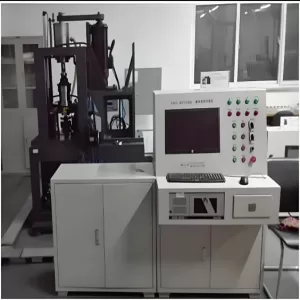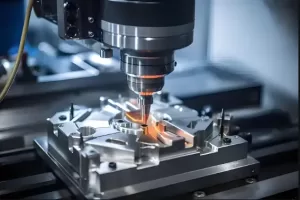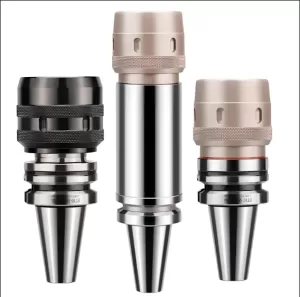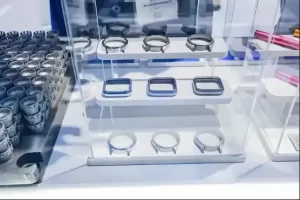January 3, 2025
Application and development of precision machining technology in CNC machining
With the rapid progress of science and technology and the continuous development of the manufacturing industry, precision machining technology and CNC technology as an important part of the manufacturing industry, are increasingly receiving attention and application. Precision machining technology with its high precision, high-efficiency features, plays an important role in the manufacture of parts and components in various industries. Numerical control technology through the computer control system to realize the intelligent operation of the machine tool, greatly improving the production efficiency and product quality.
This paper discusses the application and development of precision machining and CNC technology in the manufacturing industry, describes the principles and characteristics of CNC technology, analyzes its advantages in the realization of automated production, and flexible production, and explores the advantages of their mutual integration, as well as its positive role in improving manufacturing efficiency and optimizing the production process. Through the in-depth discussion of this paper, aims to be able to better understand the value of the application of these two technologies in the manufacturing industry, to promote the innovative development of the manufacturing industry to provide a theoretical basis and reference.
1. The concept and application characteristics of precision machining technology
1.1 Concept of Precision Machining Technology
Precision machining technology through the use of precision machining equipment and processes, as well as high-precision machining tools, precision machining of workpieces to achieve sub-micron level machining accuracy, mainly applied to the need for extremely high precision, high surface quality, and complex shape of the parts manufacturing field is mainly aimed at processing to meet the precision requirements of the shape, size and surface quality.
1.2 Application of precision machining technology in the manufacturing industry
1.2.1 Promotion of modern basic and applied sciences
The application of precision machining technology in manufacturing plays a vital role in promoting the development of modern basic and applied basic sciences.
(1)Materials science and engineering. Through precision machining, it is possible to accurately process a variety of materials, including metals, plastics, ceramics, and composite materials. This promotes in-depth research on the performance, structure, and properties of different materials, facilitates the discovery and application of new materials, and provides more material choices for the manufacturing industry.
(2)Nanoscience and nanotechnology. The application of precision machining technology on the nanoscale promotes the development of nanoscience and nanotechnology, which can realize the machining and control of micro-scale structures, thus preparing functional materials and devices on the nanoscale. These nanomaterials and devices have special physical, chemical and biological properties and have broad application prospects in the fields of nanoelectronics, nanobiotechnology, and nanomedicine.
(3)Optical science and optical engineering. Precision processing technology promotes the development of optical science and optical engineering, and the preparation of high-precision optical components, such as lenses, mirrors, prisms, etc., which have important applications in the fields of optical imaging, laser technology, optical communications, etc., and promote the progress and innovation of optical technology.
(4)Microelectromechanical systems (MEMS) and nanotechnology. The application of precision machining technology on the micro-nanometer scale has promoted the development of micro-electromechanical systems (MEMS) and nanotechnology1, and micro-sensors, micro-actuators, micro-drivers, and other micro-nanometer scale devices and systems have been prepared. These devices and systems have a wide range of applications in the fields of automatic control, biomedicine, environmental monitoring, etc., which promote the research and application of micro and nanotechnology.
1.2.2 Became an important technological support for modern high-technology warfare
In modern high-tech war, precision machining technology plays a vital role. Precision machining technology can be used for the manufacture of high-precision, high-performance weapons and equipment, military equipment, as well as a variety of key components and assemblies. the early 1990s, the United States will be listed as one of the 21 U.S. defense key technologies. The United States in 1962 developed a successful laser gyroscope, used to measure and maintain the direction and position of aircraft, missiles, and so on. Its high precision and high sensitivity make it have important application value in the military field and become one of the important equipments in the modern high-tech war.
2. CNC machining technology development and application
2.1The concept of CNC machining technology
The core of the development of modern manufacturing technology is to realize the digital enterprise, CNC machining is an important component of the digital enterprise. CNC machining (Numerical Control Machining) refers to a process method of parts processing on CNC machine tools, is the use of digital information to control parts and tool displacement machining methods, which can solve the problem of varied parts, small batches, complex shapes, high precision, is an effective way to achieve high efficiency, automated processing. Key technologies include Computer Numerical Control (Computer Numerical Control, CNC), Direct Numerical Control (Direct Numerical Control, DNC), Flexible Manufacturing System (Flexible Manufacturing System, FMS), robotics, and computer-aided process design (Computer Aided Process Plan). Computer process planning, CAPP), computer-aided testing (Computer AidedTest, CAT), computer-aided production planning (production simulation, PPS), and computer-aided production management (ComputerAided PrductionManagement). ComputerAided PrductionManagement.CAPM) and so on.

Figure 1 Rolling contact fatigue life test equipment
2.2Application of CNC machining technology
2.2.1Component processing
CNC machining technology is widely used in parts processing and manufacturing, commonly used in the processing of engine parts, body parts, etc.; in the aerospace field, CNC machining equipment for processing aircraft structural parts, spacecraft parts, etc., so that the parts of the machining and manufacturing process is more efficient and accurate.
2.2.2 Mold manufacturing
The use of CNC machining equipment can efficiently process a variety of complex shapes of molds, including plastic molds, die-casting molds, injection molds, etc., for the industrial production of high-quality mold support.
2.2.3 Customized processing
CNC machining technology has the characteristics of strong flexibility and good adaptability, for example, in the field of machinery manufacturing, customized according to customer demand can use CNC machining technology to process a variety of complex shapes of parts, such as bearing housings, gears and so on. The use of CNC machining equipment, according to customer design drawings or CAD models, through the programming control of CNC machine tools for processing, and accurate manufacture of parts and components to meet customer needs.

2.2.4 Mass production
With CNC machining equipment, you can quickly process large quantities of parts, molds, etc.. You can accurately follow the pre-set machining procedures to perform machining operations to ensure that each part of the machining is accurate and consistent, reducing the impact of human factors on product quality, reducing the scrap rate, improving production efficiency, and reducing production costs.
Application of precision machining technology in CNC machining
3.1 Machining accuracy control
Precision machining technology through high-precision machining tools, high-stability machining equipment, and precision machining technology, can realize the strict control of machining accuracy. In CNC machining, precision machining technology can optimize the machining parameters, choose the right too,l and other ways to ensure that the machining process of dimensional accuracy, surface quality, and so on to meet the design requirements.

3.2 Complex shape machining
Precision machining technology can realize the accurate processing of complex shapes of workpieces. In CNC machining, through the precision machining technology, you can utilize the multi-axis linkage of CNC machine tools, high-speed cutting, and other functions, to achieve high-precision machining of complex shapes such as complex curved surfaces and unconventional hole shapes, to meet the complex requirements of workpiece design.
3.3 Surface quality control
Precision machining technology on the workpiece surface quality requirements are very high including surface flatness, finish, surface roughness, and other aspects. In CNC machining, precision machining technology through the optimization of cutting parameters, the use of special machining processes, and other means can achieve accurate control of the surface quality of the workpiece.
(1)Cutting tool selection. Precision machining technology usually chooses high-quality, high-hardness cutting tools, such as carbide tools, single product diamond tools, these tools have high wear resistance and cutting accuracy, can realize the workpiece surface precision cutting, and improve surface quality.
(2)Cutting trajectory optimization. In precision machining technology, the use of a smooth cutting trajectory and reasonable cutting path, can reduce the machining surface of the cutting traces and cutter marks, and improve surface quality.
(3)Cooling and lubrication technology. In the machining process, appropriate cooling and lubrication technology can effectively reduce the cutting temperature, and reduce the wear of the workpiece and tool, thereby improving surface quality. The use of the appropriate amount of cutting fluid cooling, can effectively control the cutting temperature, reduce surface deformation and residual stress, and improve surface quality.
4. Precision machining technology and CNC technology integration development trend
4.1 intelligent manufacturing (religion)
Precision machining equipment and CNC systems will be more widely integrated with various types of sensors, real-time collection, and analysis of data in the machining process, which will help to achieve intelligent manufacturing monitoring, identify potential problems in advance,e and make real-time adjustments optimize the production process. At the same time to strengthen human-machine collaboration, through artificial intelligence and machine learning, CNC equipment will better understand the operator’s needs to provide a more intuitive, intelligent user interface to improve the ease of use and productivity of the equipment.
4.2 Digital Twin Technology
Through digital twin technology, the entire processing process can be simulated and optimized in a virtual environment to achieve real-time monitoring, troubleshooting, and diagnosis, improve the reliability and stability of production, promote the remote operation and maintenance of equipment, through remote monitoring, troubleshooting and maintenance, reduce downtime and improve equipment utilization.
4.3 Additive Manufacturing and Micro-Nanotechnology
The integration of precision machining technology and additive manufacturing technology will promote the manufacturing industry to a more personalized, flexible direction, through 3D printing and other technologies to manufacture precision parts, to achieve a more complex structure and higher precision processing. The precision requirements of micro-nano processing the ability to deal with small structures, and CNC technology of high-precision positioning and control fit perfectly, to promote the innovation and development of micro-nano manufacturing.

4.4 Adaptive processing technology
The introduction of an advanced feedback control system, and real-time monitoring of the surface quality of the workpiece through sensors, intelligent tools, and workpiece sensing technology will realize the real-time sensing of the material and workpiece status in the machining process, and real-time adjustment of the machining parameters to adapt to the material changes and improve the machining quality.
5. Summarize
Precision machining technology and CNC technology integration development is an important trend in the current manufacturing industry, this integration not only improves the accuracy and efficiency of parts processing but also promotes the manufacturing industry to intelligent, digital, personalized direction. Through the combination of precision machining technology and CNC technology, manufacturing enterprises can better meet market demand, improve product quality, reduce production costs, and enhance competitiveness.
In the future, with the continuous progress of science and technology, the integration of precision machining technology and CNC technology will face more challenges and opportunities.
It can be expected, that intelligent manufacturing, digital twin technology, additive manufacturing and micro-nano technology, adaptive machining technology, as well as green manufacturing and energy saving and emission reduction, and other areas of breakthroughs and innovations, will further promote the integration of precision machining technology and CNC technology for the development of manufacturing industry to bring new opportunities.